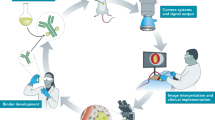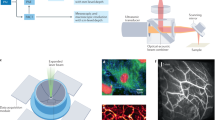Abstract
The past decade has seen dramatic technological advances in the field of optical coherence tomography (OCT) imaging. These advances have driven commercialization and clinical adoption in ophthalmology, cardiology and gastrointestinal cancer screening. Recently, an array of OCT-based imaging tools that have been developed for preclinical intravital cancer imaging applications has yielded exciting new capabilities to probe and to monitor cancer progression and response in vivo. Here, we review these results, forecast the future of OCT for preclinical cancer imaging and discuss its exciting potential to translate to the clinic as a tool for monitoring cancer therapy.
This is a preview of subscription content, access via your institution
Access options
Subscribe to this journal
Receive 12 print issues and online access
$209.00 per year
only $17.42 per issue
Buy this article
- Purchase on Springer Link
- Instant access to full article PDF
Prices may be subject to local taxes which are calculated during checkout


Similar content being viewed by others
References
Huang, D. et al. Optical coherence tomography. Science 254, 1178–1181 (1991).
Bouma, B. E., Yun, S.-H., Vakoc, B. J., Suter, M. J. & Tearney, G. J. Fourier-domain optical coherence tomography: recent advances toward clinical utility. Curr. Opin. Biotechnol. 20, 111–118 (2009).
Wojtkowski, M. High-speed optical coherence tomography: basics and applications. Appl. Opt. 49, D30–D61 (2010).
Zysk, A. M., Nguyen, F. T., Oldenburg, A. L., Marks, D. L. & Boppart, S. A. Optical coherence tomography: a review of clinical development from bench to bedside. J. Biomed. Opt. 12, 051403 (2007).
Gabriele, M. L. et al. Optical coherence tomography: history, current status, and laboratory work. Invest. Ophthalmol. Vis. Sci. 52, 2425–2436 (2011).
Suter, M. J. et al. Intravascular optical imaging technology for investigating the coronary artery. JACC.Cardiovasc. Imaging 4, 1022–1039 (2011).
Leunig, M. et al. Angiogenesis, microvascular architecture, microhemodynamics, and interstitial fluid pressure during early growth of human adenocarcinoma LS174T in SCID mice. Cancer Res. 52, 6553–6560 (1992).
Brown, E., Munn, L. L., Fukumura, D. & Jain, R. K. In vivo imaging of tumors. Cold Spring Harb. Protoc. 2010 (doi:10.1101/pdb.prot5452).
Hak, S., Reitan, N., Haraldseth, O. & de Lange Davies, C. Intravital microscopy in window chambers: a unique tool to study tumor angiogenesis and delivery of nanoparticles. Angiogenesis 13, 113–130 (2010).
Vakoc, B. J. et al. Three-dimensional microscopy of the tumor microenvironment in vivo using optical frequency domain imaging. Nature Med. 15, 1219–1223 (2009).
Winkler, A. et al. In vivo, dual-modality OCT/LIF imaging using a novel VEGF receptor-targeted NIR fluorescent probe in the AOM-treated mouse model. Mol. Imaging Biol. 13, 1173–1182 (2010).
Winkler, A., Rice, P., Drezek, R. & Barton, J. Quantitative tool for rapid disease mapping using optical coherence tomography images of azoxymethane-treated mouse colon. J. Biomed. Opt. 15, 041512 (2010).
Jugold, M. et al. Volumetric high-frequency Doppler ultrasound enables the assessment of early antiangiogenic therapy effects on tumor xenografts in nude mice. Eur. Radiol. 18, 753–758 (2008).
Badea, C. T., Drangova, M., Holdsworth, D. W. & Johnson, G. A. In vivo small-animal imaging using micro-CT and digital subtraction angiography. Phys. Med. Biol. 53, R319–R350 (2008).
Condeelis, J. & Weissleder, R. In vivo imaging in cancer. Cold Spring Harb. Perspect. Biol. 2, a003848 (2010).
Yoshioka, K. et al. A novel fluorescent derivative of glucose applicable to the assessment of glucose uptake activity of Escherichia coli. Biochim. Biophys. Acta 1289, 5–9 (1996).
O'Neil, R., Wu, L. & Mullani, N. Uptake of a fluorescent deoxyglucose analog (2-NBDG) in tumor cells. Mol. Imaging Biol. 7, 388–392 (2005).
Sheth, R. A., Josephson, L. & Mahmood, U. Evaluation and clinically relevant applications of a fluorescent imaging analog to fluorodeoxyglucose positron emission tomography. J. Biomed. Opt. 14, 064014–064018 (2009).
Nitin, N. et al. Molecular imaging of glucose uptake in oral neoplasia following topical application of fluorescently labeled deoxy-glucose. Int. J. Cancer 124, 2634–2642 (2008).
Corish, P. & Tyler-Smith, C. Attenuation of green fluorescent protein half-life in mammalian cells. Protein Eng. 12, 1035–1040 (1999).
Elliott, G., McGrath, J. & Crockett-Torabi, E. Green fluorescent protein: a novel viability assay for cryobiological applications. Cryobiology 40, 360–369 (2000).
Baumstark-Khan, C. et al. Green Fluorescent Protein (GFP) as a marker for cell viability after UV irradiation. J. Fluoresc. 9, 37–43 (1999).
Chung, E. et al. Secreted gaussia luciferase as a biomarker for monitoring tumor progression and treatment response of systemic metastases. PLoS ONE 4, e8316 (2009).
Hagendoorn, J. et al. Onset of abnormal blood and lymphatic vessel function and interstitial hypertension in early stages of carcinogenesis. Cancer Res. 66, 3360–3364 (2006).
Jain, R. K. Taming vessels to treat cancer. Sci. Am. 298, 56–63 (2008).
Isaka, N., Padera, T., Hagendoorn, J., Fukumura, D. & Jain, R. K. Peritumor lymphatics induced by vascular endothelial growth factor-C exhibit abnormal function. Cancer Res. 64, 4400–4404 (2004).
Jung, Y., Zhi, Z. & Wang, R. Three-dimensional optical imaging of microvascular networks within intact lymph node in vivo. J. Biomed. Opt. 15, 050501–050503 (2010).
Hanahan, D. & Weinberg, R. A. Hallmarks of cancer: the next generation. Cell 144, 646–674 (2011).
Carmeliet, P. & Jain, R. K. Molecular mechanisms and clinical applications of angiogenesis. Nature 473, 298–307 (2011).
Potente, M., Gerhardt, H. & Carmeliet, P. Basic and therapeutic aspects of angiogenesis. Cell 146, 873–887 (2011).
Hu, S. & Wang, L. V. Photoacoustic imaging and characterization of the microvasculature. J. Biomed. Opt. 15, 011101 (2010).
Wang, L. V. Multiscale photoacoustic microscopy and computed tomography. Nature Photonics 3, 503–509 (2009).
Su, J. L. et al. Advances in clinical and biomedical applications of photoacoustic imaging. Expert Opin. Med. Diagn. 4, 497–510 (2010).
Li, M.-L. et al. Simultaneous molecular and hypoxia imaging of brain tumors in vivo using spectroscopic photoacoustic tomography. Proc. IEEE 96, 481–489 (2008).
Brown, E. et al. In vivo measurement of gene expression, angiogenesis and physiological function in tumors using multiphoton laser scanning microscopy. Nature Med. 7, 864–868 (2001).
Boppart, S. A., Oldenburg, A. L., Xu, C. & Marks, D. L. Optical probes and techniques for molecular contrast enhancement in coherence imaging. J. Biomed. Opt. 10, 041208 (2005).
de Boer, J. & Milner, T. Review of polarization sensitive optical coherence tomography and Stokes vector determination. J. Biomed. Opt. 7, 359–371 (2002).
Farhat, G., Mariampillai, A., Yang, V. X. D., Czarnota, G. J. & Kolios, M. C. Detecting apoptosis using dynamic light scattering with optical coherence tomography. J. Biomed. Opt. 16, 070505 (2012).
Sufan, R. et al. Oxygen-independent degradation of HIF-α via bioengineered VHL tumour suppressor complex. EMBO Mol. Med. 1, 66–78 (2009).
Skala, M., Fontanella, A., Lan, L., Izatt, J. & Dewhirst, M. Longitudinal optical imaging of tumor metabolism and hemodynamics. J. Biomed. Opt. 15, 011112 (2010).
Standish, B. et al. Interstitial doppler optical coherence tomography as a local tumor necrosis predictor in photodynamic therapy of prostatic carcinoma: an in vivo study. Cancer Res. 68, 9987–9995 (2008).
Standish, B. A. et al. Interstitial Doppler optical coherence tomography monitors microvascular changes during photodynamic therapy in a Dunning prostate model under varying treatment conditions. J. Biomed. Opt. 12, 034022 (2007).
Standish, B. A. et al. in Gastrointestinal Endoscopy 326–333 (Mosby Yearbook, 2007).
Li, H. et al. Feasibility of interstitial Doppler optical coherence tomography for in vivo detection of microvascular changes during photodynamic therapy. Lasers Surg. Med. 38, 754–761 (2006).
Pircher, A. et al. Biomarkers in tumor angiogenesis and anti-angiogenic therapy. Int. J. Mol. Sci. 12, 7077–7099 (2011).
Jain, R. K. et al. Biomarkers of response and resistance to antiangiogenic therapy. Nature Rev. Clin. Oncol. 6, 327–338 (2009).
Batchelor, T. T. et al. Phase II study of cediranib, an oral pan–vascular endothelial growth factor receptor tyrosine kinase inhibitor, in patients with recurrent glioblastoma. J. Clin. Oncol. 28, 2817–2823 (2010).
Sorensen, A. G. et al. A “Vascular Normalization Index” as potential mechanistic biomarker to predict survival after a single dose of cediranib in recurrent glioblastoma patients. Cancer Res. 69, 5296–5300 (2009).
Sorensen, A. G. et al. Increased survival of glioblastoma patients who respond to anti-angiogenic therapy with elevated blood perfusion. Cancer Res. 72, 402–407 (2012).
Acknowledgements
US National Institutes of Health grants 5K25CA127465 (to B.J.V.), P01-CA080124 (to R.K.J. and D.F.), R01-CA126642 (to R.K.J.), R01-CA096915 (to D.F.), S10-RR027070 (to D.F.), a Federal Share Income Grant (to R.K.J. and D.F.), and Department of Defense Breast Cancer Research Innovator Award W81XWH-10-1-0016 (to R.K.J.). This project was supported by the Center for Biomedical OCT Research and Translation through Grant Number P41EB015903, awarded by the National Center for Research Resources and the National Institute of Biomedical Imaging and Bioengineering of the US National Institutes of Health.
Author information
Authors and Affiliations
Corresponding author
Ethics declarations
Competing interests
B.J.V. and B.E.B. are inventors on patents, owned by the Massachusetts General Hospital, USA, related to the imaging apparatus used in this research. R.K.J. receives research grant funding from Dyax, MedImmune and Roche; is a consultant for Dyax and Noxxon; is on the Scientific Advisory Boards of Enlight, SynDevRx; is on the Board of Trustees of H&Q Capital Management; and is a cofounder of Xtuit Pharmaceuticals. D.F. declares no competing financial interests.
Related links
FURTHER INFORMATION
Supplementary information
Supplementary information S1 (movie)
Time-lapse angiography and microstructural imaging of tumours in response to VEGFR2 blockade (MOV 2613 kb)
Rights and permissions
About this article
Cite this article
Vakoc, B., Fukumura, D., Jain, R. et al. Cancer imaging by optical coherence tomography: preclinical progress and clinical potential. Nat Rev Cancer 12, 363–368 (2012). https://doi.org/10.1038/nrc3235
Published:
Issue Date:
DOI: https://doi.org/10.1038/nrc3235
This article is cited by
-
Experimental and theoretical model of microvascular network remodeling and blood flow redistribution following minimally invasive microvessel laser ablation
Scientific Reports (2024)
-
Hyperthermic Treatment by Superparamagnetic Iron Oxide Nanoparticles for Targeted Tumor Therapy: An In-Vivo Approach Guided by Swept-Source Optical Coherence Tomography
Journal of Medical and Biological Engineering (2023)
-
Intravital 3D visualization and segmentation of murine neural networks at micron resolution
Scientific Reports (2022)
-
Virtual histological staining of label-free total absorption photoacoustic remote sensing (TA-PARS)
Scientific Reports (2022)
-
Metasurface-based bijective illumination collection imaging provides high-resolution tomography in three dimensions
Nature Photonics (2022)



